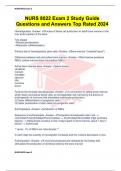Exam (elaborations)
NURS 8022 Exam 2 Study Guide Questions and Answers Top Rated 2024
- Course
- Institution
Hematopoiesis -Answer- Process of blood cell production in adult bone marrow or the liver and/or spleen of the fetus Two stages ▪ Mitosis (proliferation) ▪ Maturation (differentiation) Primary site of hematopoietic stem cells -Answer- Bone marrow ("myeloid tissue") Difference betwe...
[Show more]



